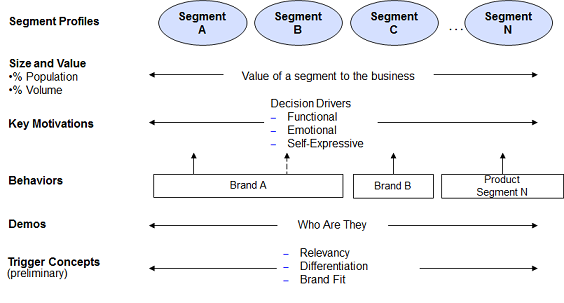Customer Framework Development
A key component of any strategic marketing, branding, or innovation project is developing a customer segmentation framework to inform where to play opportunities. Customer framework development also helps structure the market to manage the customer experience on a segmented basis.
Think of it as the intersection of market segmentation, customer journey mapping, and customer experience. We use the term “customer framework” vs. “customer segmentation” to reflect a more robust, foundational set of deliverables
The customer framework can either be hypothesized qualitatively or developed through a quantified segmentation study.
The diagram shows information obtained through framework development:

The framework itself consists of three interrelated elements— customer segments, potential needs, and strategic opportunity areas.
(For service-based brands, a fourth ‘customer experience’ element can be added, resulting in a customer experience management framework.)
Think about a customer framework as a strategic chessboard: Across the top, align customer groups your organization could potentially serve. Then, on the left, group market-based opportunities: What needs do customers have? What benefits are they seeking? What jobs need to be done? Any areas of unmet need represent unoccupied white space opportunities. Like a master chess player, this allows a company to strategically identify, plan for, and move into new demand spaces, making the competition irrelevant.
Goal
Major Activities
Key Deliverables
Key outputs of this step are used as an input into concept development and optimization.
















Follow EquiBrand